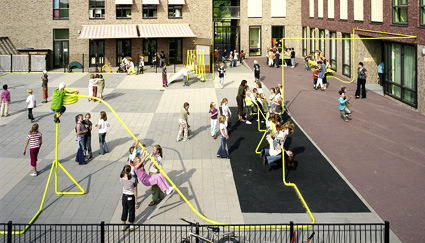
This is as much an art installation as a out-of-the-box playground design. If I knew more Dutch (is it Dutch?) I’d probably be able to give you more information, but as for now, you can simply head on to the artist’s site.

This is as much an art installation as a out-of-the-box playground design. If I knew more Dutch (is it Dutch?) I’d probably be able to give you more information, but as for now, you can simply head on to the artist’s site.
The media landscape today’s definitely a vastly different one than just twenty years ago. Effective advertisements of yore were mass-blasted through the conventional channels: TV, Mass Print, radio, etc. Most of the time, the effectiveness of the campaign scaled rather proportionally with your pockets.
With recent developments in technology, we’re seeing the emergence of a whole new ballgame. We can now skip past the ads in TV program segments. We probably don’t even watch TV all that much – preferring to get our stuff through the Internet, sans advertisements, at our own time and pace. We’re freed from the confines of having to sit through commercials, infomercials – we can effectively filter them now.
What, then, happens to the conversation between the advertiser and the consumer? This video explores.
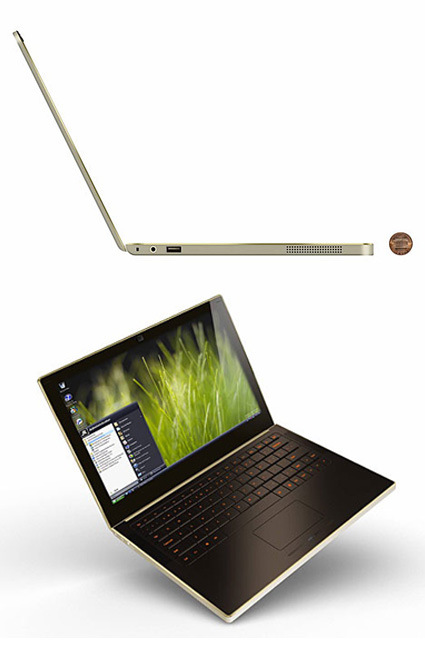
Wow. That’s a really thin and cool laptop. Designed by ZIBA with Intel’s engineers, it is what most people would ask for in their dream laptops. Name it: 0.7 inches thick, 1kg weight, Flash drive (no more scary spinning hard disk – they’re much more stable), 14 hours battery life (Flash drive requires much less power than hard disks), and a folder for the laptop that is also its charger.
For now it’s still a prototype, but let’s hope it’d come true. Quickly. And cheaply.
[Business Week has more detail]

India’s largest automaker is set to start producing the world’s first commercial air-powered vehicle. The Air Car, developed by ex-Formula One engineer Guy Nègre for Luxembourg-based MDI, uses compressed air, as opposed to the gas-and-oxygen explosions of internal-combustion models, to push its engine’s pistons. Some 6000 zero-emissions Air Cars are scheduled to hit Indian streets in August of 2008.
With a top speed of 68mph and a 125 mile range, this car might be a little shabby for a full-fledged family car, but they are decent enough for urban transit, especially considering the cost: 340 liters of air compressed at 4350 psi can be refilled in a few minutes, at only $2.
I have always wondered about the validity of an “air-car” though. While it certainly sounds very green – powered by air, does no harmful emissions at all – physics tells me that the work required to compress the air would have to involve some sort of energy input somewhere, whether it be at the car’s compressor, or the delivery pump. What do these pumps run on? Oil? Electricity? Is the compressed-air engine more efficient than the combustion engine?
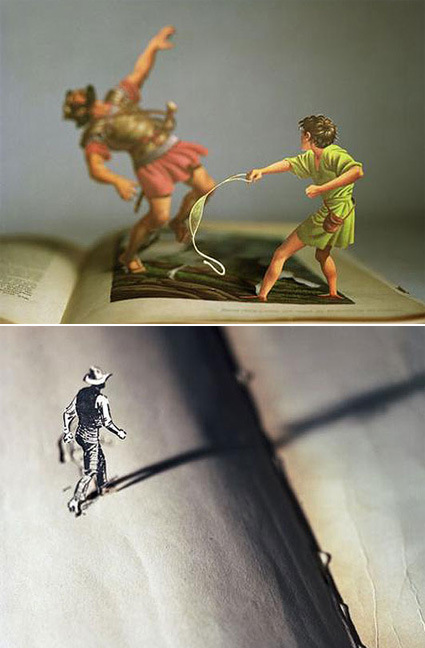
Allen’s photographs are inspired by his childhood experiences with pop-up books and View-Masters. He begins his process by cutting figures and images out of illustrated pages of old books and vintage fiction novels. Allen then cleverly rearranges and juxtaposes the forms to create three-dimensional scenes. Next, he carefully lights his subjects and photographs the scenes.
Extremely poetic, don’t you think?
[link]
Here’s an amazing effort by a professor in a university to illustrate what copyright means. The entire movie was narrated by a continuous montage of narrative derived from snippets of Disney’s movie (which perfectly illustrates the principle of fair use as satire). It’s quite refreshing to see this rehash as a retort to the sometimes absurd legal measures taken by copyright owners like Disney! It also shows how money and power corrupts since by using money gained from copyrighted work, a portion of that money was (and still is) used to pay (bribe) our politicians (congress and senate) to continually extend the copyright time limits. The whole intent of limiting this was to spur new ideas and work, however, as with may things, we the people let this happen by re-electing the bribed politicians.

Haha, if you ever need some real, honest-to-(not so)goodness e-cards, here are some really good ones. Just about stripping away every sense of human cordiality in exchange for a jab of brutal honesty (nice designs too!).
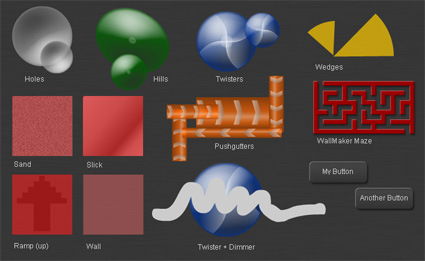
PowerCursor is a Flash toolkit that web designers can embed in their designs to have interfaces with tactile properties – like slope, roughness, motion, etc. – by simulating them in terms of visual feedback. For instance, if you hover your cursor over the “Hills” area, your mouse cursor moves much slower when going “upslope”; if you run your cursor in the “Maze”, it can only follow the paths, etc. This brings yet another dimension into websites that are traditionally thought of as flat papers – “webpages“.
The application could be interesting – giving textures to a website. For now I can’t quite imagine a site which would be enhanced by this – maybe Flash games. I just hope that Flash web interface designers would take a page from history: let’s not have a whole barrage of “texture-enabled” websites that serves little to enhance, or even deteriorate, the usage experience, ala “Skip Flash Intro”.
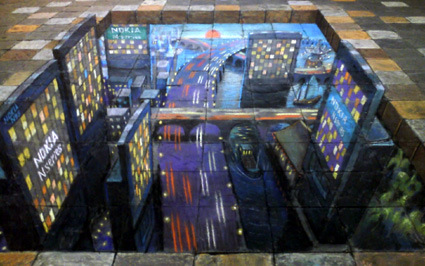
For those of you who’re in Singapore, you might have noticed that a tent has been set up for an artist to sketch on the pavement tiles the past few days. While you may not know the name of this artist, it’s quite likely that you’ve seen some of his works whether in forwarded emails or links to the website, where he draws anamorphic illusions on pavements using chalk. When seen from a particular perspective, the drawing looks like 3D in perspective. Here’s a link to the archive of his works.
Above is the drawing – more commercialized and straightforward than some of his other decidedly more tantalizing works. It’s a pity, but I guess someone has to foot the bill after all.
[Is it just me or does the boat in the canal near the bridge looking like a gorilla baring its teeth?]

Some of you might be laughing at me for this – but I’d be the first to admit – I didn’t know baby carrots weren’t baby carrots. I always thought they were either carrots that were harvested early, or a species of carrot that were genetically meant to be that small. So, if you’re like me and have no idea where does baby carrots come from, read on:
Baby carrots are not young carrots, but rather small pieces of carrots that are chopped and whittled down to look like small carrots. They are peeled, and washed, and insanely convenient.
Ah – baby carrots come from real, normal carrots! Those carrots that are too knobby, twisted, ugly to be sold as normal carrots were cut down to form this much more pleasant looking – dare I say cute and adorable – baby carrots (what a perfectly-coined marketing term to erase any notions of its more imperfect, less-innocent past!).
Which made me think: some of the more packaged/refined foods are also derived from these less-appealing (appearance-wise) foods – think of all the juices, potato chips, wedges, etc. – since they’re relieved of the burden to look pretty in their natural states, they are able to carry on a new identity powered through by packaging and marketing. And a whole lot more expensive than the original ones too (baby carrots usually sell for maybe 3-5 times more expensive than standard ones).
Moral of the story: don’t look at just the appearance. Recognize the inner potential, and groom it to its fullest!